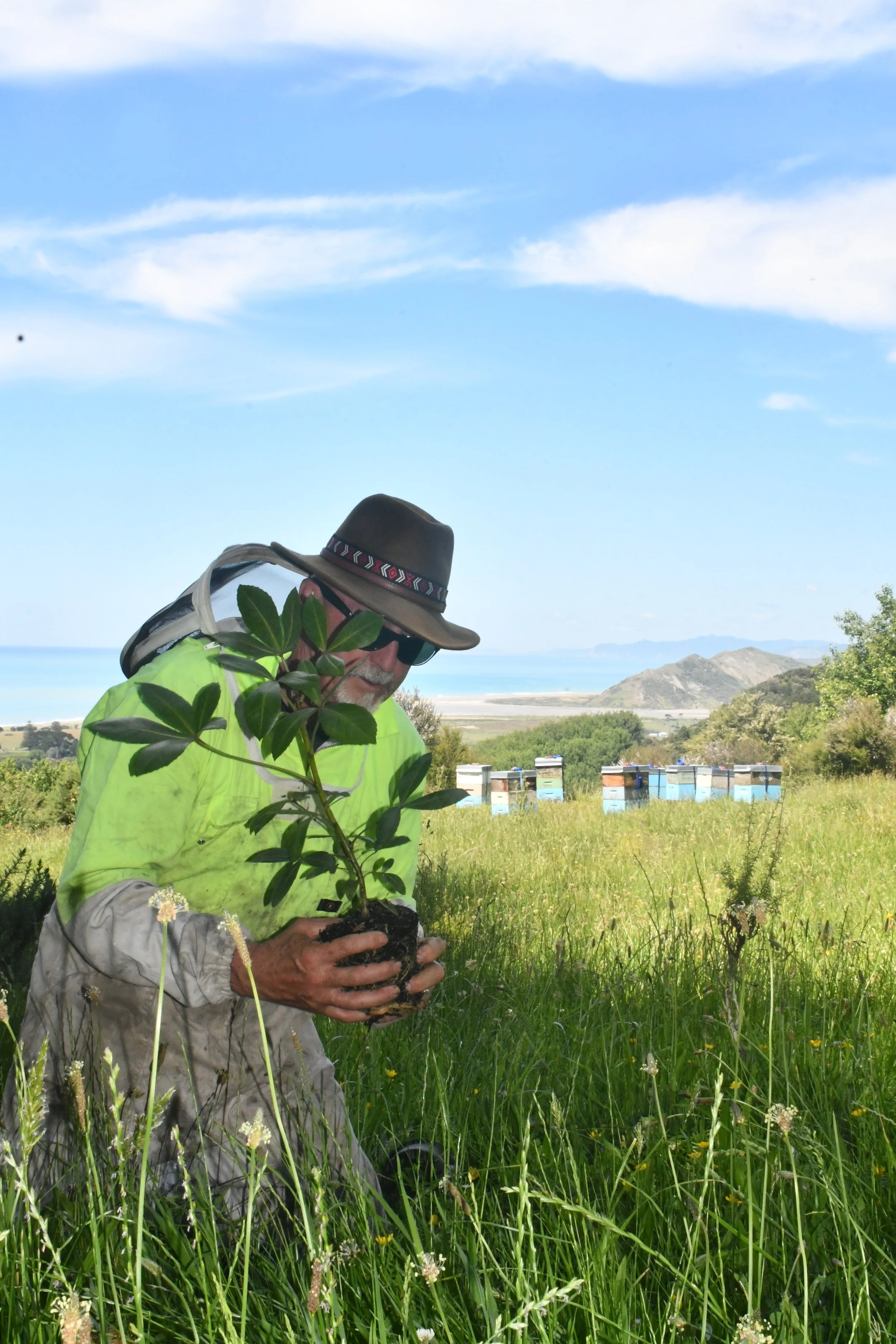Hive and Thrive: The RāKiwi Regeneration
The East Coast of New Zealand, known for its rugged beauty and tight-knit communities, is home to an innovative collaboration for environmental regeneration. RāKiwi, a premium mānuka honey business, is going beyond producing world-class honey; it is also focused on regenerating the land by blending traditional conservation practices with cutting-edge technology.
Hives at Te Kautuku: where regeneration meets premium mānuka honey.
Technology being developed by Toha and piloted through East Coast Exchange will integrate real-time data and spatial mapping to track and verify every stage of the regeneration process on land blocks where RāKiwi’s honey supply is generated—from seed collection to planting, ensuring transparency, accountability, and scalability. RāKiwi is more than just a honey business; it is a part of a larger movement aiming to restore the environment while cultivating a sustainable model for apiculture.
At the heart of this effort is Brendan Shivnan, a Gizzy-bred, Piha-based conservationist and the driving force behind RāKiwi. With deep-rooted connections to the land, Brendan’s passion for conservation is infectious, 2% of RāKiwi’s revenue is committed to recloaking the whenua, and it extends much deeper than planting trees. “RāKiwi isn’t just about trees,” says Brendan. “It’s about returning to the land what was taken from it. Every tree we plant is an act of respect to the land and the people who’ve come before us. When I’m out there collecting mānuka seeds, I’m not just thinking about the plants. I’m thinking about the future—the future of the land, the people, and the ecosystem.”
Brendan Shivnan: proudly repping Te Araroa while regenerating the land.
Brendan’s stories about his connection to the land and the personal significance of each seed planted are what distinguish RāKiwi’s approach. “I’ve been working on this project for years, and what I’ve learned is that the land is patient,” he reflects. “The land will tell you what it needs. The more we listen, the more we can help it recover.” For him, the regenerative process is a calling, not just a job, and his personal investment in the community and the land is evident in everything he does.
The uniqueness of RāKiwi’s honey lies in its exceptional connection to the land, where every element of production—from the regeneration process to the harvesting—is meticulously crafted to ensure the highest quality product. The honey's distinctiveness is rooted in the regeneration of the local ecosystem, as the mānuka trees thrive in a balanced, restored environment. RāKiwi’s honey benefits from the specific biodiversity of the lands on which it is harvested, offering a taste profile unmatched by mass-produced mānuka honey. The relationship between the regenerative process and the final product is what sets RāKiwi apart, making it not only a strong example of environmental stewardship but a premium, high-value commodity.
Mānuka in bloom: the delicate flower behind RāKiwi’s world-class honey and environmental regeneration efforts.
“I love that Brendan gets hands-on collecting seeds, planting and really listening to the kaitiaki of the whenua and understanding what it needs,” says Izzi Morris, product manager consultant to East Coast Exchange. “It builds incredible trust between the local community and RāKiwi. With technology and data, we can extend that trust and connection to RāKiwi customers, too.” Through Toha’s spatial mapping technology, RāKiwi can share the progress of every planting site and show the journey of the trees from the point of seed collection and germination to planting and growth into mature forest.
Esther Raroa, who lives and works on the land at the pilot site Te Kautuku and is equally inspired by the project, adds, “We’re not just planting trees—we’re creating a legacy. Every action we take, whether it’s collecting seeds or verifying planting locations, is part of something much bigger. We want people to know they’re investing in something that will last far beyond this generation.” For her, RāKiwi is more than a distributor for their honey; it’s a way of restoring balance to the land by engaging local communities in long-term environmental stewardship.
Despite the use of advanced technology in this project, Brendan maintains that the personal touch is key to the initiative. “For me, every tree, every seed, is deeply personal,” he says. “When I’m planting, I’m not thinking about just the trees. I’m thinking about future generations, about the children who will come to this land and experience what we’ve restored. It’s about reconnecting people to the environment and to each other.”
The process of honey production is intrinsically linked to the land's restoration. By regenerating the native flora, including mānuka trees, RāKiwi is enhancing the region’s biodiversity and creating a more sustainable environment for its production. Brendan explains, “The land gives us everything we need, and we are simply returning the favour. Each tree planted represents a step forward for the future.”
From nectar to nature.
From a commercial standpoint, this integration of cutting-edge technology will truly set RāKiwi apart. “It’s not just about having a unique product—it's about making the entire process transparent,” says Brendan. “For us, transparency isn’t just a buzzword; it’s an essential part of how we demonstrate our commitment to both sustainability and quality.” In short, consumers will be able to trace each jar of RāKiwi honey back to its origins, seeing which trees were planted, where they came from, and the conditions in which they were nurtured.
When you scan the QR code on RāKiwi packaging, you’re not just accessing product details—you’re connecting with the story behind the honey. You’re stepping into the heart of the regeneration project and seeing the journey from seed to jar. This level of traceability sets us apart in a crowded market, offering something far more authentic than just another jar of honey. “It’s an experience for the consumer—one that ties them directly to the land, the people, and the sustainable practices that make RāKiwi so special,” Brendan adds.
Beyond the story, the hope for both RāKiwi and ECX is that the data behind each tree and planting event can lead to enhanced consumer confidence. Ensuring that land management decisions are informed by best practices and mapped against global sustainability standards is not just good for nature, it makes commercial sense for RāKiwi too. “In nearly every category we are seeing environmentally conscious consumers switch to products that align with their values. Investing in this mahi is a smart commercial strategy,” says Izzi. Ultimately, the transparency built into the product’s lifecycle, alongside the authenticity of our mission, gives RāKiwi the opportunity to stand out as much more than just a premium mānuka honey brand.
Rooted in the future: Brendan planting hope one tree at a time, regenerating the East Coast for generations to come.
As RāKiwi’s efforts continue to grow, the project is poised to leave a lasting impact on the East Coast and beyond. “This model being piloted with RāKiwi is set to be rolled out across a range of sites and food supply chains in the next 18-24 months.” says Izzi. “With the right tools, we can scale the impact without losing the trust and community-led spirit that makes this project so special.”
The combined efforts of Brendan, Izzi, Esther, their organisations and the local community are making this a model for regenerative agriculture. With hands-on work backed by cutting-edge technology, this collaboration is proving that sustainable, meaningful change is possible. RāKiwi is creating a blueprint for future regeneration projects, one that combines personal relationships with technology to protect and restore the environment for generations to come.
📸 Photos by Cory Scott
🌐 RāKiwi website






